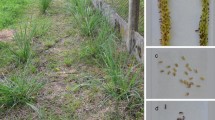Summary
Diploid parthenogenetic and androgenetic plants were found in certain interspecific hybrid combinations in diploid Solanum. Self progenies of parthenotes of S. verrucosum appeared highly uniform and 100% homozygous for resistance to Race 1.2.3.4 of Phytophthora infestans. They can be of prime importance for breeding if homozygous lines are needed.
Diploid androgenetic plants occur among interspecific hybrid progenies in Solanum. They could be used to investigate the effect of different plasmons on several characters.
Similar content being viewed by others
References
Abdalla, M. M. F., 1970. Inbreeding, heterosis, fertility, plasmon differentiation and Phytophthora resistance in Solanum verrucosum Schlechtd., and some interspecific crosses in Solanum. Agric. Res. Rep. Wageningen 748.
Bingham, E. T., 1969. Haploids from cultivated alfalfa, Medicago sativa L. Nature, Lond. 221: 865–866.
Chase, S. S., 1969. Monoploids and monoploid-derivatives of maize (Zea mays L.). Bot. Rev. 35: 117–167.
Goodsell, S. F., 1961. Male sterility in corn by androgenesis. Crop Sci. 1: 227–228.
Hammond, B. L., 1966. Homozygous diploid sugar beets. J. Am. Soc. Sugar Beet Tech. 14: 75–78.
Hougas, R. W. & Peloquin, S. J., 1958. The potential of potato haploids in breeding and genetic research. Am. Potato J. 35: 701–707.
Katayama, Y. & Adachi, T., 1969. Studies on the haploidy in relation to plant breeding. IV. Parthenogenetic development induced by alien pollen. Seiken Zihô 21: 31–35.
Kermicle, J. L., 1969. Androgenesis conditioned by a mutation in maize. Science 166: 1422–1424.
Nishi, S., Kuriyawa, T. & Hiraoka, T., 1964. Studies on the breeding of crucifer vegetables by interspecific and intergeneric hybridization. I. Special reference to the utilization of matroclinous hybrids accompanied with pseudogamous phenomena in those hybridizations. Bull. hort. Res. Stn, Japan, Ser. A No 3: 161–250.
Röbbelen, G., 1966. Beobachtungen bei interspezifischen Brassica-Kreuzungen, insbesondere über die Entstehung matromorpher F1-Pflanzen. Angew. Bot. 39: 205–221.
Stokes, G. W., 1963. Development of complete homozygotes of tobacco. Science 141: 1185–1186.
Turcotte, E. L. & Feaster, C. V., 1967. Semigamy in Pima cotton. J. Hered. 58: 55–57.
Turcotte, E. L. & Feaster, C. V., 1969. Semigametic production of haploids in Pima cotton. Crop Sci. 9: 653–655.
Author information
Authors and Affiliations
Rights and permissions
About this article
Cite this article
Abdalla, M.M.F., Hermsen, J.G.T. Diploid parthenogenesis and androgenesis in diploid Solanum . Euphytica 21, 426–431 (1972). https://doi.org/10.1007/BF00039338
Received:
Issue Date:
DOI: https://doi.org/10.1007/BF00039338




